Oct 4, 2017
Best places to view autumn leaves around Tokyo, how much it costs to get to them
The Japanese really do have a fetish for looking at leaves, petals … and more recently, moss. Early October sees the greater Tokyo / Kanto region of Japan on the cusp of one of the great “foliage gawping” seasons - koyo (紅葉 - sometimes referred to as “momiji”, although this is actually the name of the Japanese maple tree). Koyo means "autumn leaves". Unlike the spring alternative of cherry blossom which comes with it the noun / verb “hanami”, pointing to those parties where you sit under a cherry blossom tree and (largely) get drunk, Japan’s koyo has no such attached vocabulary. In fact, the chill of the season lends itself more to a brisk walk and gawp rather than any breaking out of the picnic finery and staying put for a few hours. The frank terminology “autumn leaves” however, does not do justice to the ferocious outbreak of color that breaks across swathes of Japan when these leaves assume their fall collection. The best spots to view autumn leaves, and by this we mean the most dramatic, around Tokyo / Kanto, will likely take some getting to as many of the best seats in the house are located on the sides of mountains, and down in valleys and gorges. It’s not always thus though. Some of the autumn leaf spots remain perfectly accessible from the capital.
In the interests of honesty, this list of the best places to view autumn leaves was compiled by … looking at other lists, of which there are many. We looked at both Japanese and English-language lists and selected those places that cropped up with the greatest frequency.
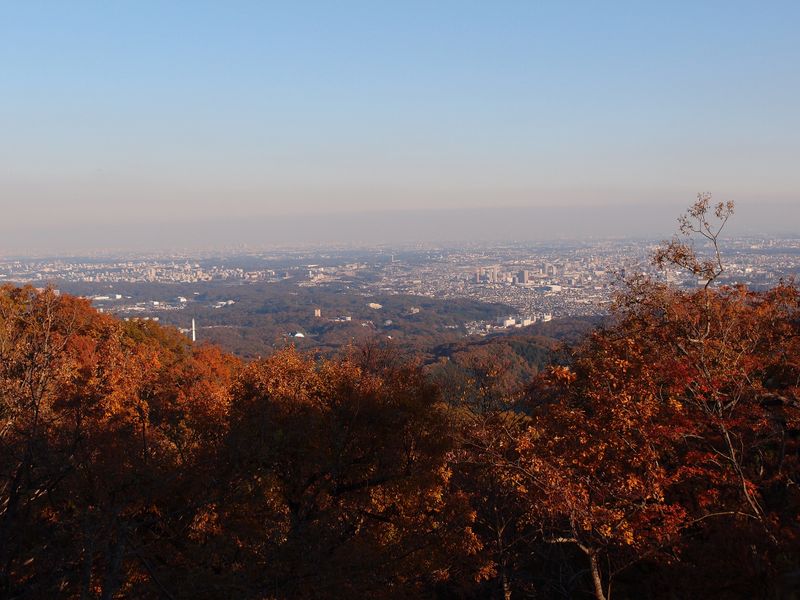
Mount Takao (Tokyo)
No surprise to see 高尾山 / Takaosan, the easy Tokyo-getaway staple on lists such as this. This diminutive peak with its straightforward access, views to Mt. Fuji, and variety of walking trails, eateries and facilities is something of a default destination for Tokyoites wanting to get out of the city for the day. It’s countryside light, if you will. Still, if you’re not in some sort of fettle, the climb to the top can still be a lung buster.
Despite such proximity to Tokyo, Mt. Takao affords the visitor some pretty spectacular scenery and can feel far removed from urban life, but for the number of people here. These numbers will increase significantly during the “koyo” season (Takao-san is one of the favored spots). Expect leaves on the slopes of Mt. Takao to be at their fiery autumnal best around mid to late November.
How much does it cost to get there from Tokyo Station? 1,050 yen
Example course …
TOKYO - (JR Chuo Special Rapid) - TAKAO - (Keio Takao Line) - TAKAOSANGUCHI
Journey time: ~ 70 mins
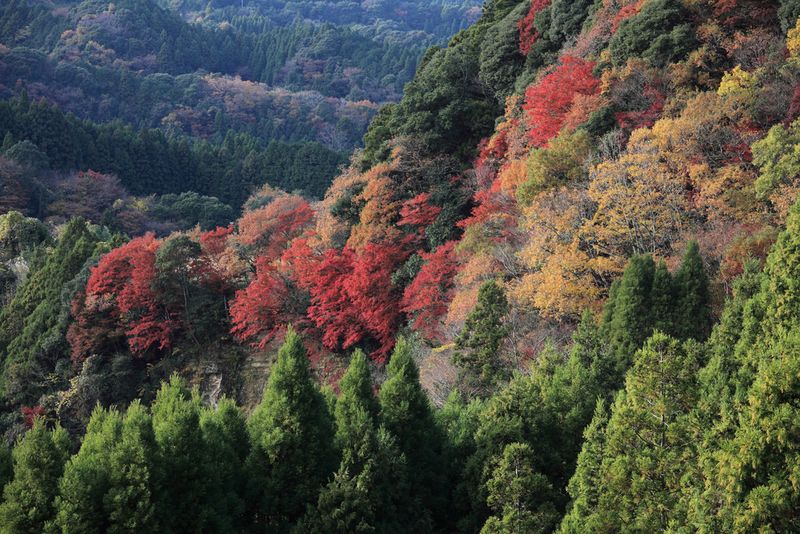
Yōrō Keikoku Okukiyosumi Prefectural Natural Park (Chiba)
Maybe it will be a surprise to see this tongue-twister named park in Chiba on any list of autumn leaf spots. On the other hand, maybe any surprise is simply a reflection of this expat’s ignorance, as Yōrō Keikoku Okukiyosumi Prefectural Natural Park appears on numerous “koyo” lists.
The park takes its name from the Yōrō Valley and the Kiyosumi Mountains around which much of the land spreads. The park has much to offer including waterfalls, temples, plum blossoms (February), and riverside walks. Oh, and blazing autumn leaves, particularly around the Umegase Valley. In fact, the upper reaches of the Yōrō Valley are something of a hiking Mecca (in Chiba, at least) with hiking courses branching out from numerous stations on the Kominato Railway.
The best time for viewing autumn leaves in this part of Japan is from late November to early December. Along with the Umegase Valley, Awamata no Taki (waterfall) and the Tsutsumori Maple Valley are spots to look out for.
How much does it cost to get there from Tokyo Station? 2,220 yen
Yoro Keikoku Station on the abovementioned Kominato Railway seems to be a good base for exploring Yōrō Keikoku Okukiyosumi Prefectural Natural Park.
Example course …
TOKYO - (JR Sobu Line Rapid) - CHIBA - (JR Uchibo Line) - GOI - (Kominato Railway) - YOROKEIKOKU
Journey time: ~ 150 mins
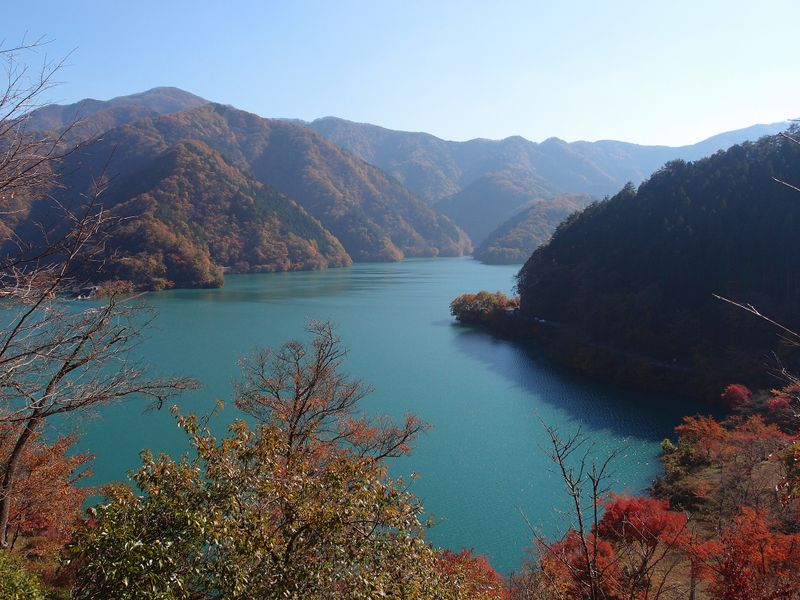
Lake Okutama (Tokyo / Yamanashi)
Like your autumn leaf colors reflected on the surface of a lake? If so, then maybe Okutama-ko (Lake Okutama / 奥多摩湖) could be worth a look. This artificial lake (also known as Oguchi Reservoir) straddles the border between Tokyo and Yamanashi Prefectures and is surrounded by mountain peaks dressed to the nines in their autumnal coats, i.e. there are lots of fall leaves to see here. On a fine day, when the lake surface is playing its part, you can get some nice shots of the colors reflecting off the water. With a view over the lake / reservoir the Tsukiyomi 1st Parking Area is recommended as spot from which to view autumn leaves in the area, as is the drive along the Okutama Shuyu Road besides which the parking area is located.
Autumn leaf viewing in this area is best between early October and mid-November.
How much does it cost to get there from Tokyo Station? 1,600 yen
There is no train access available all the way to Lake Okutama. Autumn leaf watchers will have to head first to Okutama Station and take buses from there to the lake region. Warning! You may need to search for “Oku-tama” station rather than “Okutama”.
Example course to Okutama Station …
TOKYO - (JR Chuo Special Rapid) - TACHIKAWA - (JR Ome Line) - OME - (JR Ome Line) - OKUTAMA
Journey time: ~ 130 mins
From out front of Okutama Station look out for Nishi Tokyo Buses (西東京バス) to Okutama Lake
Journey time: ~ 15 mins

Nagatoro (Saitama)
The small town of Nagatoro (長瀞) in Saitama sits in the famed Chichibu District with the town in its entirety being part of a nature park (at a prefectural level). Sounds promising then. The autumn leaf viewing in these parts centers on the Arakawa River (Or should that just be Ara River?) and the Iwadatami rocks (designated as a “Place of Scenic Beauty”) that flank one side of the flowing waters. Boating is big business on these waters (typically “driven” by people brandishing long poles, the boats that is) so views to the surrounding autumn leaves from the pleasantries of a waterborne vessel could be a highlight for many. Tsukihoshi Momiji Park (about 1 km south of Nagatoro Station) is host to illuminations during the fall.
The best time for viewing autumn leaves in these parts is from mid to late November.
How much does it cost to get there from Tokyo Station? 1,900 - 4,500 yen
Those in a hurry might want to use the Nagano Shinkansen.
Example course …
TOKYO - (Nagano (Asama) Shinkansen) - KUMAGAYA - (Chichibu Railway) - NAGATORO
Journey time: ~ 100 mins
Those who want to keep their journeys cheaper …
TOKYO - (JR Takasaki Line) - KUMAGAYA - (Chichibu Line) - NAGATORO
Journey time: ~ 140 mins
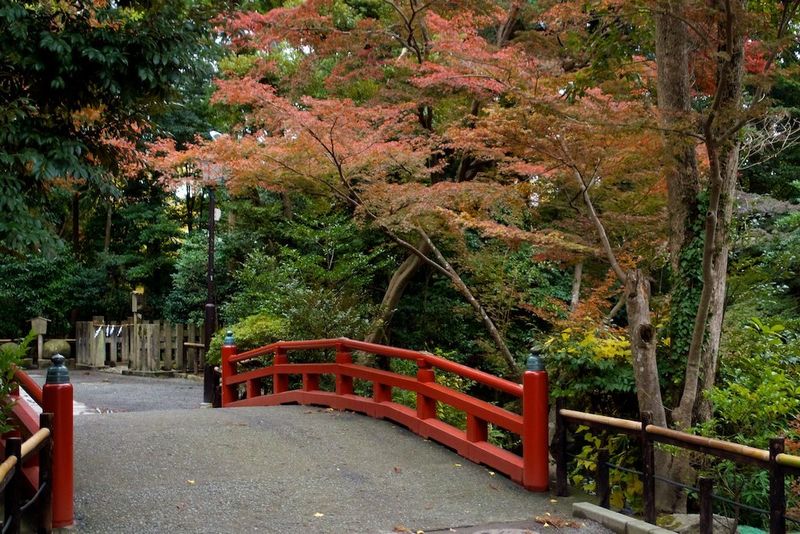
Tsurugaoka Hachimangu Shrine (Kamakura, Kanagawa)
As if Kamakura wasn’t popular enough, this splendid area south of Tokyo can also boast of splendid spots from which to gawp at the autumn leaves. The loudest boast seems to be coming from tourist-itinerary permanent resident, Tsurugaoka Hachimangu Shrine (鶴岡八幡宮).
Proximity to the area’s main travel hub of Kamakura Station makes Tsurugaoka Hachimangu all too easy to visit, and very popular. Still, these things are usually popular for good reason, and with or without the rich hues of autumn foliage, this central Kamakura shrine is indeed handsome. Throw in those leaves then, and it’s “cameras at the ready”! While the main structure of the shrine sits atop an all-too-steep set of stairs, the gravel covered grounds that surround the base make for a much more pleasant stroll, with garden features, one of those only-in-Japan bridges and, of course, plenty of trees.
What’s going to exacerbate the popularity of this autumn foliage viewing spot is its ease of access and lack of any need to strap on the hiking boots to get the best out of it. Elbows at the ready then!
Early to late November for the best of the leaves.
How much does it cost to get there from Tokyo Station? 920 yen
Example course …
TOKYO - (JR Tokaido Line) - OFUNA - (JR Yokosuka Line) - KAMAKURA
Journey time: ~ 60 mins
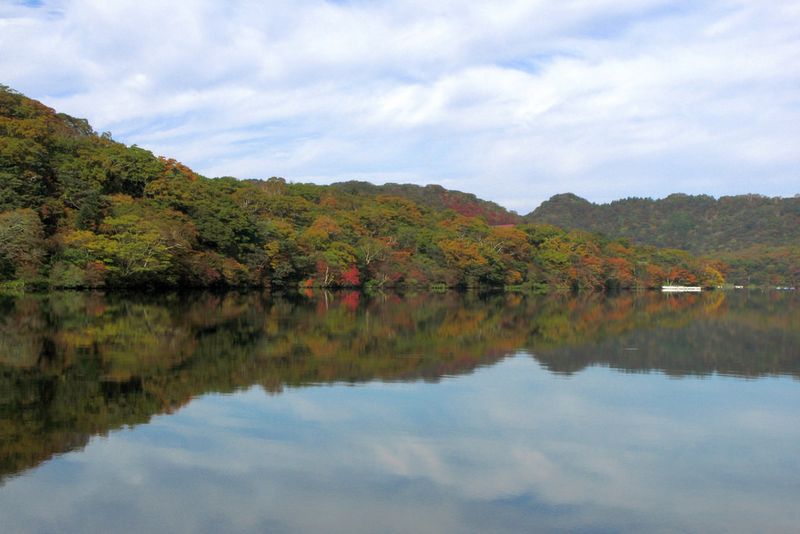
Mount Akagi (Gunma)
In Mount Akagi (Akagi-yama / 赤城山) you actually have three peaks shoehorned into one umbrella name. Still, three is better than one and Mount Akagi is featured as one of the “100 Famous Japanese Mountains” as picked for the much celebrated mountaineering tome of the same name written by Kyuya Fukada in the 1960s.
This expat has never read the book, so I can’t be sure what it has to say, if anything, about the autumn leaves on Gunma’s Mt. Akagi. Classic literature aside though, the mountain seems to be a regular feature on lists about the best places to see autumn foliage around Tokyo. So, here it is on another one!
There are three caldera lakes up there on Mt. Akagi. Lake Onuma seems to be a popular spot for eyeing up the leaves, surrounded as it is by peaks abundant in nature (including trees with nice leaves, presumably). The contrast between the reds and yellows seen directly and those seen in the reflection of the lake waters are reportedly a stunning highlight. The grassy lands around another caldera lake, Kakumanbuchi, are also a good all-round-spot for autumn leaf viewing.
The leaves are likely to be at their most resplendent from mid October to early November. The challenge of accessing Mt. Akagi from Tokyo, together with the mountain scenery and required hiking makes this an autumn foliage viewing spot for the more determined type.
How much does it cost to get there from Tokyo Station? ~ 6,500 yen
Mount Akagi is one of the most challenging spots on this list to reach from Tokyo (in fact, maybe it’s pushing it to include it on such a list in the first place). First point of order will be trains to Maebashi which will likely involve the Hokuriku or Nagano Shinkansen.
Example course …
TOKYO - (Hokuriku (Hakutata) Shinkansen) - TAKASAKI - (JR Ryomo Line) - MAEBASHI
Journey time: ~ 80 mins
From Maebashi Station it’ll be a couple of buses to the Mt. Akagi Visitors Center. Take a Kan-etsu Kotsu Bus bound for Fujimi Onsen. Get off at the last stop and change to a bus by the same company all the way to the visitors center (赤城山ビジターセンター).
Journey time: ~ 70 mins
Hananuki Valley (Ibaraki)
Ibaraki Prefecture is perhaps not an area one would typically associate with dramatic valleys, but here we are, northeast of Tokyo, enjoying another of the best autumn leaf viewing spots in the Kanto area. The viewing action of the Hananuki Valley (花貫渓谷) centers on a suspension bridge (Shiomitakitsuri Bridge / 汐見滝吊り橋 / Shiomi Waterfall Suspension Bridge), 60 m in length, that spans a narrow part of the valley and a small stream below. It’s from up here on the bridge that visitors can get some sense of being in a tree canopy, and a colorful one at that. The valley varies in depth and is home to waterfalls that add to the sense of being in amongst the nature. Enthusiasts can extend their outdoor experience with a stay at the Kotakizawa Camping Ground a few hundred meters northwest of the main action.
Come here from mid to late November for the best of the autumn leaves.
How much does it cost to get there from Tokyo Station? ~ 10,000 yen
Travel to the Hananuki Valley is going to involve a taxi. From Tokyo Station, the first leg of the journey with be trains to Takahagi Station.
Example course …
TOKYO - (Limited Express Hitachi) - TAKAHAGI
Fare: ~ 5,000 yen
Journey time: ~ 110 mins
From Takahagi Station a taxi the Kotakizawa Camping Ground will cost around 4,000 yen.
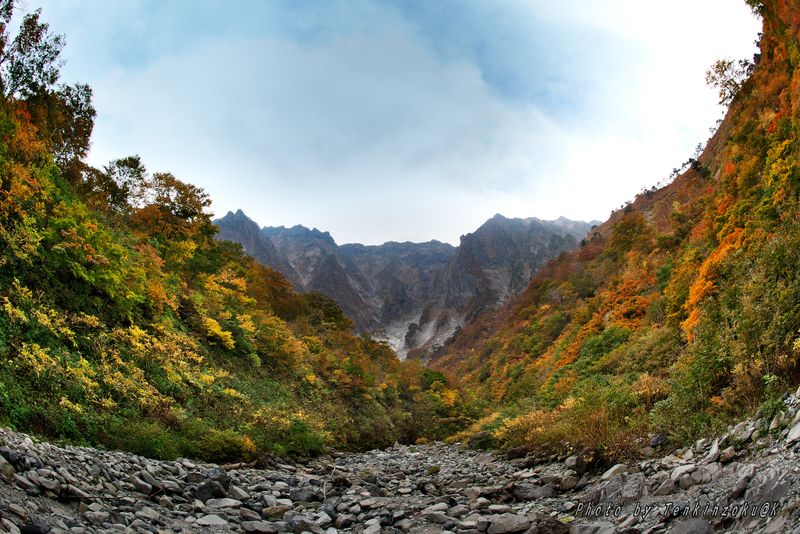
Mount Tanigawa (Gunma / Niigata)
Another one of those “100 Famous Japanese Mountains”, Mt. Tanigawa (谷川岳 / Tanigawadake) rises to some 1977m, every one of them looking pretty dramatic and rugged. In autumn, the peak makes for a suitably magnificent backdrop to the blazing foliage.
Some of the hiking around here can be a challenge and should be approached with care. There are easier trails in the area though, and these should be stuck to by those without climbing / mountaineering experience. Despite the rugged nature of things around here, we’re still in Japan, as such there is a ropeway (the Tanigawadake Ropeway) which can take visitors to viewing point at around 1,300m.
How much does it cost to get there from Tokyo Station? ~ 7,000 yen
Getting from Tokyo to the Mt. Tanigawa area will involve the Hokuriku or Nagano Shinkansen.
Example course …
TOKYO - (Hokuriku (Hakutata) Shinkansen) - TAKASAKI - (JR Joetsu Line) - MINAKAMI
Journey time: ~ 140 mins
From Minakami Station buses depart for the lowest station of the Tanigawadake Ropeway.
Fare: 670 yen
Journey time: ~ 20 mins
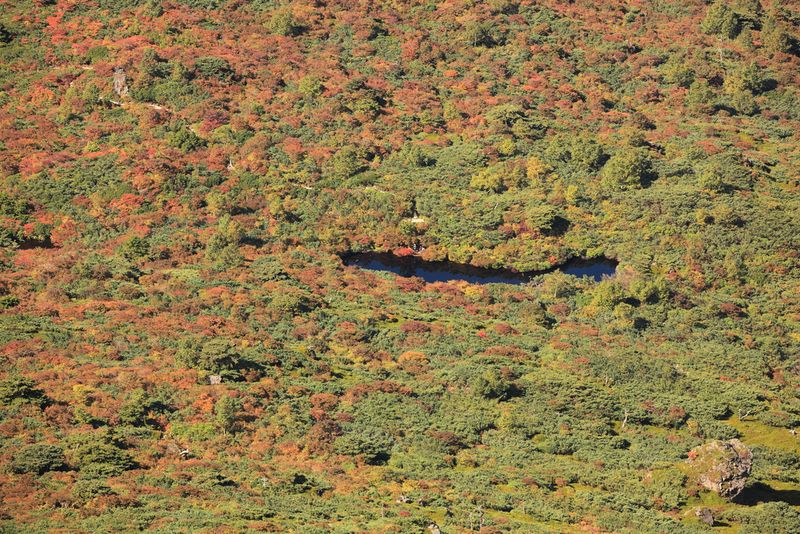
Nasukogen (Tochigi)
The Nasu Highlands (Nasukogen / 那須高原) appear to be at the upper echelons of many lists for the best places to view autumn leaves around Tokyo. Certainly, this is some nice country dominated by the broad mountain slopes of Chausudake (茶臼岳), and filled with fresh air, and plenty of trees.
Chausudake, from top to bottom is a good spot for checking out the surrounding autumn leaves. A ropeway tackles most of the climb, leaving a 40-minute romp to the summit (where weather conditions are very changeable, so come prepared).
The slopes of Chausudake change their colors pretty early from the start of October to the middle of the month so it’s time to get a wriggle on if we want to be heading here for our foliage. Still, should we miss it, there’s always the Nasu Garden Outlet Mall (accessed from Nasushiobara Station) where we can indulge in some comfort spending.
How much does it cost to get there from Tokyo Station? 4,000 - 7,500 yen
Nasushiobara Station is a good travel hub for exploration of the area.
Example course …
Tōhoku Shinkansen can take travellers directly from Tokyo Station to Nasushiobara Station.
Fare: ~ 6,000 yen
Journey time: ~ 70 mins
Without the Shinkansen fares can be cut in half …
TOKYO - (JR Utsunomiya Line) - UTSUNOMIYA - (JR Utsunomiya Line) - NASUSHIOBARA
Fare: ~ 2,500 yen
Journey time: ~ 160 mins
From Nasushiobara Station buses depart for destinations that include Shiobara and Nasu Onsen. Between April and November buses are available all the way to the Nasu Ropeway.
Fare (to the ropeway): 1,400 yen
Journey time: ~ 80 mins
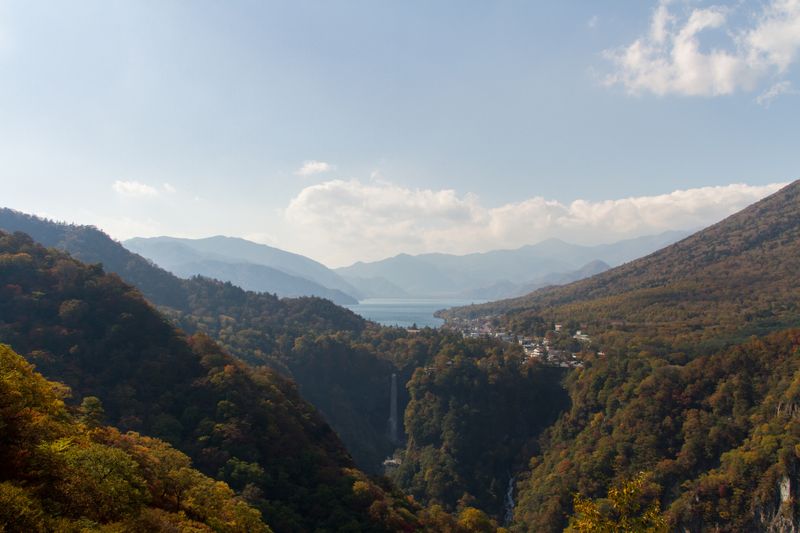
Lake Chuzenji, Nikko (Tochigi)
No list of places to view autumn leaves around the Tokyo / Kanto area was ever going to not include Nikko in some form or other. This weekend-getaway favorite has a number of spots from which the foliage can be enjoyed - Ryūzu Falls, Yumoto Onsen, Shinkyo Bridge … the list goes on. Lake Chuzenji (Chūzenjiko / 中禅寺湖), however, perhaps provides the most panoramic or immersive autumn leaf experience, surrounded as it is by foliage covered mountains which might be reflected in the lake waters should the weather play its part. With plenty of opportunities to stretch the legs, places to stop for a bite to eat, accommodation options and waterfalls nearby (Kegon Falls), these along with relatively easy access from the capital make the lake region a worthy addition to any autumn foliage list.
The leaves around Chuzenji are already starting to change, but the colors won’t really kick in until mid October.
How much does it cost to get there from Tokyo Station? ~ 4,000 yen
First we need to get to Nikko / Tobu-Nikko Stations.
Example course …
TOKYO - (JR Joban Line) - KITA-SENJU - (Tobu Limited Express) - SHIMO-IMAICHI - (Tobu Nikko Line Local) - TOBU-NIKKO
Fare: ~ 3,000 yen
Journey time: ~ 150 mins
From Tobu-Nikko Station buses make the journey to Chuzenjiko Onsen.
Fare: 1,150 yen
Journey time: 50 mins
See more about getting from Tokyo to Nikko
Now, there are probably so many gaping absences from this list of the best places to view autumn leaves around Tokyo as to make the collation of any such list questionable. Still, we have to start somewhere, and the fact that the spots listed above appear across numerous lists (created by locals and foreigners alike) must speak for something.
After looking into the costs and journey times to reach these posts from Tokyo, it’s become clear that some of the best views would be better served by an overnight stay, certainly for those travelling from central Tokyo. Tsurugaoka Hachimangu in Kamakura remains, perhaps, the easiest entry on our list for access from the capital but Nagatoro (Saitama), Yōrō Keikoku Okukiyosumi Prefectural Natural Park (Chiba), Mt. Takao (Tokyo), and Lake Okutama (Tokyo / Yamanashi) are also legitimate day-trip autumn foliage viewing options.
Of course, one doesn’t have to leave the city in order to enjoy the colors of autumn, plenty of parks, river banks, and green spaces in the capital will be breaking out their “fall collections”, usually during November.
Hopefully though, this post will spark a bit of debate, internal or online, about the best places to view the autumn leaves, not just in and around Tokyo, but across the whole of Japan.
See us on …
Twitter: @City_Cost_Japan
Facebook: @citycostjapan
Images
Mt. Takao: Guilhem Vellut Flickr License
Yōrō Keikoku Okukiyosumi Prefectural Natural Park: TANAKA Juuyoh (田中十洋) Flickr License
Lake Okutama: Guilhem Vellut Flickr License
Nagatoro: Richard, enjoy my life! Flickr License
Tsurugaoka Hachimangu: houroumono Flickr License
Mount Akagi: TANAKA Juuyoh (田中十洋) Flickr License
Mount Tanigawa: BJ TENKINZOKU Flickr License
Nasukogen: TANAKA Juuyoh (田中十洋) Flickr License
Chuzenji: Christophe Robin Flickr License



0 Comments